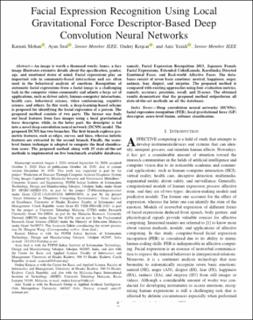| dc.description.abstract | An image is worth a thousand words; hence, a face image illustrates extensive details about the specification, gender, age, and emotional states of mind. Facial expressions play an important role in community-based interactions and are often used in the behavioral analysis of emotions. Recognition of automatic facial expressions from a facial image is a challenging task in the computer vision community and admits a large set of applications, such as driver safety, human-computer interactions, health care, behavioral science, video conferencing, cognitive science, and others. In this work, a deep-learning-based scheme is proposed for identifying the facial expression of a person. The proposed method consists of two parts. The former one finds out local features from face images using a local gravitational force descriptor, while, in the latter part, the descriptor is fed into a novel deep convolution neural network (DCNN) model. The proposed DCNN has two branches. The first branch explores geometric features, such as edges, curves, and lines, whereas holistic features are extracted by the second branch. Finally, the score-level fusion technique is adopted to compute the final classification score. The proposed method along with 25 state-of-the-art methods is implemented on five benchmark available databases, namely, Facial Expression Recognition 2013, Japanese Female Facial Expressions, Extended CohnKanade, Karolinska Directed Emotional Faces, and Real-world Affective Faces. The databases consist of seven basic emotions: neutral, happiness, anger, sadness, fear, disgust, and surprise. The proposed method is compared with existing approaches using four evaluation metrics, namely, accuracy, precision, recall, and f1-score. The obtained results demonstrate that the proposed method outperforms all state-of-the-art methods on all the databases. | en_US |
| dc.description.localcode | © 2020 IEEE. Personal use of this material is permitted. Permission from IEEE must be obtained for all other uses, in any current or future media, including reprinting/republishing this material for advertising or promotional purposes, creating new collective works, for resale or redistribution to servers or lists, or reuse of any copyrighted component of this work in other works. | en_US |
